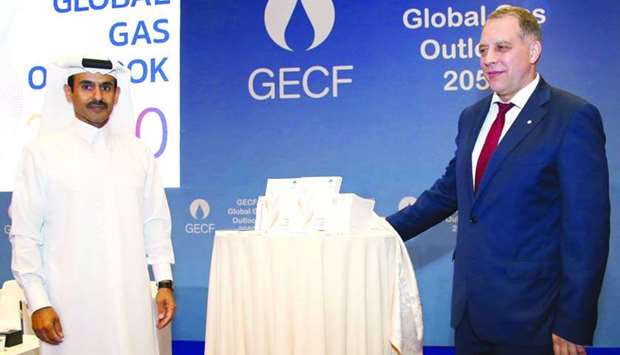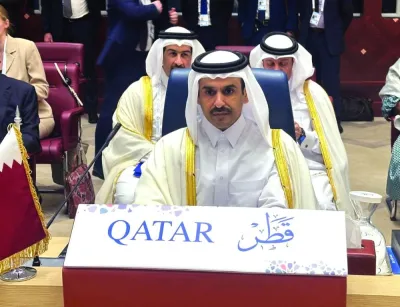Qatar and four other producing countries will lead the growth in liquefied natural gas (LNG) export capacity over the next three decades during which $9.7tn has been earmarked for investment in the gas sector.
Besides Qatar, the US, Australia, Russia and Mozambique are projected to lead the growth in export capacity. With more than 120mn tonnes per year of liquefaction capacity under construction and another 260mn tpy planned, the share of LNG exports will rise from the current 37.2% to 45.2% of total exports by 2030, and to 50.3% by 2050.
Gas production in GECF countries will grow by almost 50% by 2050 to over 2.5tcm, underlining the continued importance of the group, according to the "Global Gas Outlook 2050" released in Doha Monday.
Growth in LNG trade is the main driving force and will exceed total pipeline trade by 2050, whereas in 2018 it was only just over half pipeline trade, the outlook said.
The LNG sector is expected to grow at 2.9% to 1,077bcm by 2050, while pipeline trade will expand more slowly at a rate of 1.2% per year to reach 1,063bcm by 2050.
LNG liquefaction capacity is set for a period of rapid growth, doubling by 2050, with many projects scheduled to come on stream in the next seven to 10 years.
Natural gas, the outlook noted, continues to receive positive policy support in several countries as an alternative to polluting and carbon-intensive fuels and a flexible option complementing intermittent renewables.
However, this policy support is challenged, especially with governments setting more ambitious renewables targets and decisions by several lenders, including the World Bank to discontinue financing gas projects.
For renewables, there is increasing reliance on market-based instruments such as auctions and renewable certificates trading, and fewer regulatory subsidies (such as feed in tariffs).
The outlook anticipates a short- to medium-term slowdown of solar photovoltaics (PV) and wind capacity additions due to feed-in tariffs reduction and shift of renewables support schemes, but sees expansion over the longer term, driven by decreasing costs and ambitious renewables targets.
“Coal is under greater threat, with several governments, cities and companies announcing bans on coal utilisation. Where countries still support the use of coal, this is increasingly linked to ‘clean coal’ technologies such as super-critical power plants which reduce the environmental impact of coal utilisation.
“The global anti-nuclear policy following the Fukushima disaster continues to wane in the context of countries’ strengthening commitment to lower their greenhouse gas (GHG) emissions. Plans to close existing nuclear plants are likely to progress more slowly, although in the longer term the lack of competitiveness of nuclear is likely to restrict growth,” it said.
Carbon pricing is emerging as a key carbon mitigation instrument with new initiatives announced since the 2018 GGO, notably in Canada, Argentina, Singapore and South Africa. Despite the Trump administration position against a strengthened climate effort, several individual US states (eg New Mexico, Oregon, California) are pursuing carbon pricing. It is estimated that one-third of the 2050 global energy-related CO2 emissions will be covered by carbon pricing of some sort.
The GECF Outlook expects that enhanced climate commitments by countries, supplemented by efforts of sub-national governments and business actors, will drive further reduction of CO2 emissions compared to the '2018 GGO forecasts'.
However, it anticipates that the implemented policies will not be sufficient to meet the ambitious Paris Agreement targets while satisfying the energy needs for a growing global population and economy.
Energy-related CO2 emissions are expected to increase by around 0.13% a year over the 2018-2050 period, a low growth rate reflecting a large anticipated deceleration of emissions. This deceleration will occur, specifically after 2030, where emissions are projected to stabilise and reach around 36 GtCO2 by 2050.
Natural gas is set to be responsible for the lowest share in global CO2 emissions by 2050 (27%) despite its highest contribution to the primary energy mix (31%).
Coal, however, is projected to be the largest contributor to 2050 global emissions with the lowest share in the primary energy mix.
“This carbon mitigation advantage puts gas in a good position to achieve further global emissions reductions by substitution for coal,” the GECF outlook noted.
Gas production in GECF countries will grow by almost 50% by 2050 to over 2.5tcm, underlining the continued importance of the group, according to the "Global Gas Outlook 2050" released in Doha Monday.
Growth in LNG trade is the main driving force and will exceed total pipeline trade by 2050, whereas in 2018 it was only just over half pipeline trade, the outlook said.
The LNG sector is expected to grow at 2.9% to 1,077bcm by 2050, while pipeline trade will expand more slowly at a rate of 1.2% per year to reach 1,063bcm by 2050.
LNG liquefaction capacity is set for a period of rapid growth, doubling by 2050, with many projects scheduled to come on stream in the next seven to 10 years.
Natural gas, the outlook noted, continues to receive positive policy support in several countries as an alternative to polluting and carbon-intensive fuels and a flexible option complementing intermittent renewables.
However, this policy support is challenged, especially with governments setting more ambitious renewables targets and decisions by several lenders, including the World Bank to discontinue financing gas projects.
For renewables, there is increasing reliance on market-based instruments such as auctions and renewable certificates trading, and fewer regulatory subsidies (such as feed in tariffs).
The outlook anticipates a short- to medium-term slowdown of solar photovoltaics (PV) and wind capacity additions due to feed-in tariffs reduction and shift of renewables support schemes, but sees expansion over the longer term, driven by decreasing costs and ambitious renewables targets.
“Coal is under greater threat, with several governments, cities and companies announcing bans on coal utilisation. Where countries still support the use of coal, this is increasingly linked to ‘clean coal’ technologies such as super-critical power plants which reduce the environmental impact of coal utilisation.
“The global anti-nuclear policy following the Fukushima disaster continues to wane in the context of countries’ strengthening commitment to lower their greenhouse gas (GHG) emissions. Plans to close existing nuclear plants are likely to progress more slowly, although in the longer term the lack of competitiveness of nuclear is likely to restrict growth,” it said.
Carbon pricing is emerging as a key carbon mitigation instrument with new initiatives announced since the 2018 GGO, notably in Canada, Argentina, Singapore and South Africa. Despite the Trump administration position against a strengthened climate effort, several individual US states (eg New Mexico, Oregon, California) are pursuing carbon pricing. It is estimated that one-third of the 2050 global energy-related CO2 emissions will be covered by carbon pricing of some sort.
The GECF Outlook expects that enhanced climate commitments by countries, supplemented by efforts of sub-national governments and business actors, will drive further reduction of CO2 emissions compared to the '2018 GGO forecasts'.
However, it anticipates that the implemented policies will not be sufficient to meet the ambitious Paris Agreement targets while satisfying the energy needs for a growing global population and economy.
Energy-related CO2 emissions are expected to increase by around 0.13% a year over the 2018-2050 period, a low growth rate reflecting a large anticipated deceleration of emissions. This deceleration will occur, specifically after 2030, where emissions are projected to stabilise and reach around 36 GtCO2 by 2050.
Natural gas is set to be responsible for the lowest share in global CO2 emissions by 2050 (27%) despite its highest contribution to the primary energy mix (31%).
Coal, however, is projected to be the largest contributor to 2050 global emissions with the lowest share in the primary energy mix.
“This carbon mitigation advantage puts gas in a good position to achieve further global emissions reductions by substitution for coal,” the GECF outlook noted.




